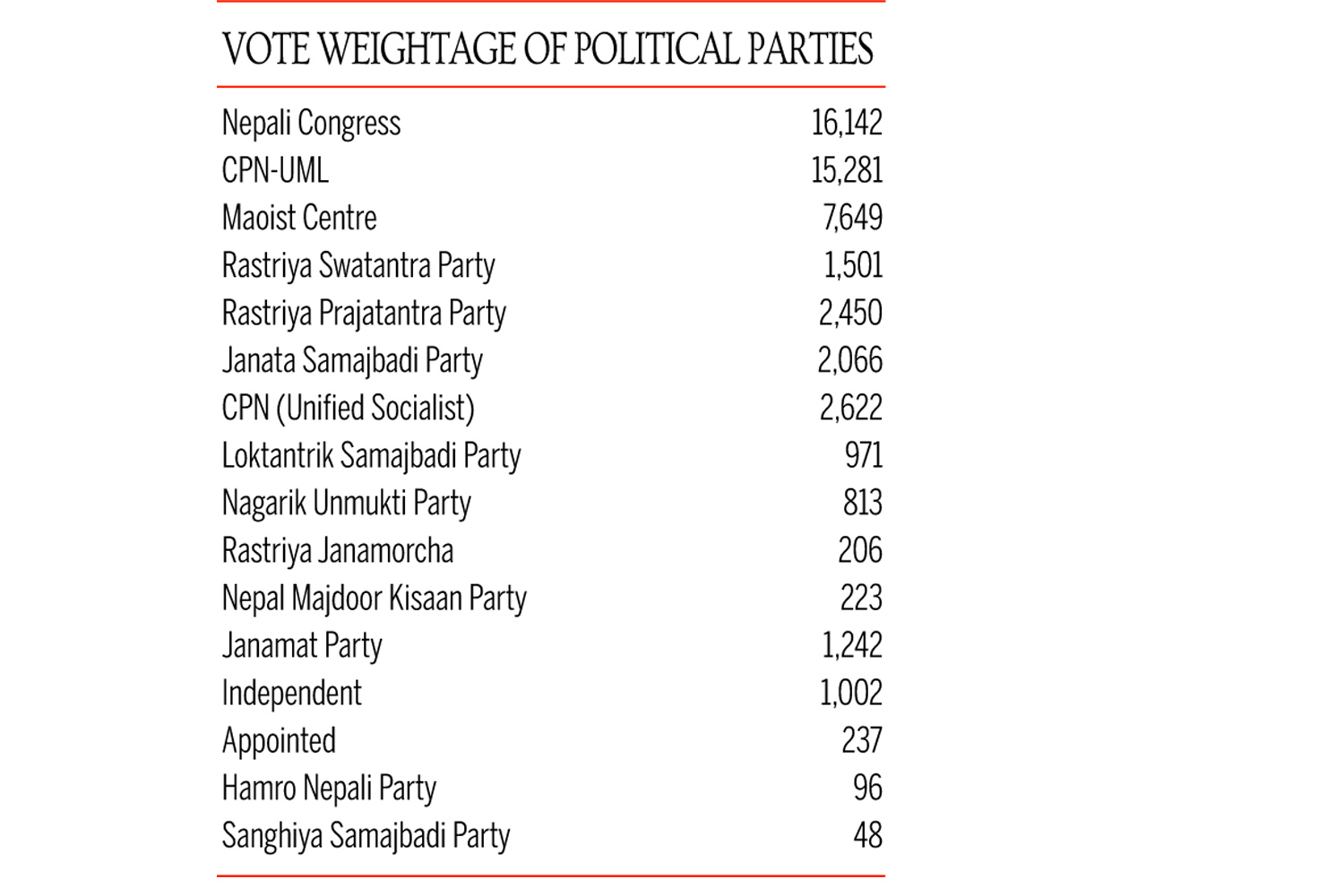Politics
Presidential elections in Nepal—past and present
An overview of the upcoming election, which will pick republic Nepal’s third President, and its brief history.
Nishan Khatiwada
Months of haggling over Nepal’s presidential election has culminated into a showdown between two experienced politicians: Nepali Congress senior leader Ram Chandra Paudel and CPN-UML vice-chair Subas Nembang. The leaders, both of whom have previously served as Speaker of the House of Representatives, filed their candidacies on Saturday.
As things stand, Paudel is most likely to get elected as the next head-of-state as he has the backing of eight parties—the Congress, plus the CPN (Maoist Centre), the Janata Samajbadi Party, the CPN (Unified Socialist), the Janamat Party, the Loktantrik Samajbadi Party, the Nagarik Unmukti Party and the Rastriya Janamorcha. No other party has as yet declared its support for Nembang’s candidacy.
Election calendar
The election, which will pick Nepal’s third president, is scheduled for March 9. The Election Commission has already published the election calendar.
As the nomination is completed on Saturday, complaints, if any, against the candidates should be filed on Sunday and Monday. A candidate willing to withdraw can do so on February 26, which is also the day for the publication of the final candidate list.
The commission has given March 1-8 for the election campaign. The vote will be conducted on March 9 and the results will be declared on the same day.
Weighted voting system
The election of the President is held based on a weighted voting system.
Article 62 (1) of the constitution states: “The President shall be elected by an electoral college composed of the members of the federal parliament and the provincial assemblies. The voting weightage of the members of the federal parliament and of the provincial assemblies shall vary as provided for in the federal law.”
A total of 884 members make up the electoral college, including 275 members of the House of Representatives, 59 of the National Assembly and 550 of the seven provincial assemblies. It means, there will be a total weightage of 52,786 votes in the electoral college, if no seat in federal parliament and provincial assembly is vacant. A candidate must secure a majority of the total votes to secure the top post.
A total of 881 lawmakers will cast the vote in the upcoming presidential election, if no one abstains.

The eight-party alliance in favour of Nepali Congress candidate Paudel has a total vote weightage of 31,711 votes, which is more than enough for a win. The UML, on the other hand, has a vote weightage of 15,281 votes. As no party has openly claimed their support to the UML so far, its chances are slim.
Even if it gets the support of the Rastriya Prajatantra Party and the Rastriya Swatantra Party that have been close to the UML, they will have a combined weightage of 19,232 votes. To secure a win, the UML must bring other parties on board.
The UML has already started wooing them.
Paudel’s candidacy was proposed and seconded by key leaders of the eight parties. It was proposed by Congress President Sher Bahadur Deuba, the CPN (Unified Socialist) Chairman Madhav Kumar Nepal, Maoist Centre’s Senior vice-chair Narayan Kaji Shrestha, the Federal Council Chairman of the Janata Samajbadi Party Ashok Rai and Abdul Khan of the Janamat Party.
Likewise, the candidacy was seconded by President of Loktantrik Samajbadi Party Mahanta Thakur, Congress vice-president Purna Bahadur Khadka, Nagarik Unmukti Party Chairperson Ranjita Shrestha, Chairman of the Rastriya Janamorcha Chitra Bahadur KC and Maoist Centre’s Hitraj Pandey.
This suggests the Nepali Congress candidate will get majority votes. Yet Nepali politics is full of surprises. Both the candidates will try their level best to become the head of state, which has become a crucial position.
No majority or a tie
The constitution has also envisaged a situation of no candidate securing a majority.
Article 62 (3) states that a person who secures a majority of the then existing total votes of the electoral college referred to in Clause (1) shall be elected as President.
Article 62 (4) states: “In case none of the candidates secures a majority pursuant to Clause (3), there shall be the voting between the two candidates who have secured the highest number of votes, and a candidate who secures more than 50 percent of the total votes in such voting shall be elected as the President.”
If there is a tie in case the two candidates secure an equal number of votes, according to the Act on Presidential and Vice Presidential Elections, the President will be elected via a lucky draw (drawing of lots).
History of presidential election in Nepal
The first presidential election saw a neck-and-neck competition.
In July 2008, Nepali Congress leader Ram Baran Yadav was elected the first president of the republic, defeating the Maoist-backed candidate Ramraja Prasad Singh. The 594-member strong Constituent Assembly elected Yadav to the post, as 308 of the 590 votes cast went in his favor. Maoist Centre had emerged as the largest party from the first Constituent Assembly election 2008. The country had just abolished the monarchy.
Singh, Yadav’s closest competitor, got 282 votes. The Rastriya Prajatantra Party (Nepal) had abstained from voting.
None of the candidates for the presidential election secured a majority in the first round of voting that was held two days before. So, Yadav and Singh had contested the second round. Yadav’s candidacy, in the second voting, was supported by the UML and the Madheshi Janadhikar Forum.

In October 2015, UML’s Bidya Devi Bhandari was elected the first woman president of Nepal, with a wider margin. She secured 327 votes while her closest competitor Kul Bahadur Gurung of Nepali Congress garnered 214 votes. Out of the 597 lawmakers, 549 took part in the voting held in the parliament. Eight votes were deemed invalid. The ruling CPN-UML, the UCPN (Maoist), the Rastriya Prajatantra Party-Nepal, and the Madhesi Janadhikar Forum Loktantrik, among others, had backed Bhandari in the election.
At the time, the UML had just got to lead the government, with party leader KP Sharma Oli elected as the prime minister earlier in the month. Bhandari’s election came shortly after the promulgation of the Constitution on September 20, 2015, which defined Nepal as a secular state and divided into seven provinces, adopting a federal structure.
The 2018 presidential election was based on the weighted voting system and electoral college. Bhandari was reelected in March 2018, securing nearly three-fourth of the vote strength of the electoral college.
Of 52,501 votes by weightage, President Bhandari secured 39,275 votes while Nepali Congress candidate Kumari Laxmi Rai got 11,730 votes. Of the 884 members of the Electoral College, 879 were eligible voters. But only 862 participated. The Sanghiya Samajbadi Forum, the Rastriya Janata Party, the Rastriya Janamorcha and the Rastriya Prajatantra Party voted in Bhandari’s favour while the Sajha Bibeksheel, the Naya Shakti and the Nepal Majdoor Kisan Party abstained from voting.
Bhandari had the backing of the left alliance, including the UML and the Maoist Centre. The alliance had secured a historic victory in the federal and provincial elections in 2017. The 2015 presidential election was held based on the old system, as the provinces were yet to be set up.
But three years later, after the seven provinces were set up and federal and provincial lawmakers elected, the presidential election came to be based on a weighted voting system.




 16.92°C Kathmandu
16.92°C Kathmandu















